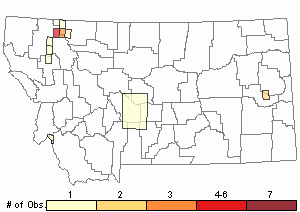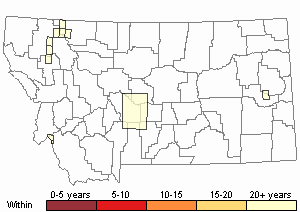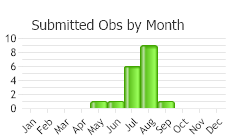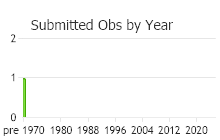View in other NatureServe Network Field Guides
NatureServe
Montana
Utah
Wyoming
Idaho
Wisconsin
British Columbia
South Carolina
Yukon
California
New York
A Dicranum Moss - Dicranum bonjeanii
General Description
Plants: Acrocarpous. Growing in open clumps of erect shoots, shiny, yellow or yellow with green tones. Stems 2-8 cm; rhizoids pale to russet, barely forming a woolly mat (FNA 2007).
Leaves: Spreading somewhat to loosely upright next to the stem (FNA 2007), sometimes curved to one side (Smith 1980), similar in dry and moist conditions, moderately to strongly wavy crosswise, sometimes slightly cupped, 3.5-6 mm in length, 1-1.5 mm in width, the base lance-shaped, becoming nearly tubular distally due to the incurved margins, the apex nearly obtuse, the upper stem frequently with egg-shaped leaves tipped with a short subula; margins saw-toothed above mid-leaf; costa subpercurrent, occasionally with 2 dorsal, dentate crests near the apex (easiest to see in X-section) (FNA 2007).
Leaf Cells: Lamina 1 cell-layer thick, the cells smooth, the walls lacking bulges; distal laminal cells wavy and short, very slender, porose (FNA 2007); lower laminal cells slender and quadrangular (Smith 1980), wavy and long, porose; alar cells distinct, inflated (FNA 2007), brownish (Smith 1980), the alar region occasionally reaching the nerve, 2 cell-layers thick; costa in X-section with faint ventral and dorsal stereid bands, a guide cell row, the superficial ventral cells not distinct, the superficial dorsal cells with just a few distinct cells distally (FNA 2007).
Phenology
Fruit ripens in spring (FNA 2007).
Diagnostic Characteristics
This species is easily confused with the numerous variable characteristics of Dicranum scoparium. However, D. scoparium typically has 4 toothed, dorsal crests on the costa near the leaf apex rather than 2, and prefers soil or humus in dry to moist woods, bottoms of trees and old wood rather than eutrophic fens (FNA 2007).
Range Comments
North American Range
AK and NT, BC to NL and NS, WA, OR to WY, MI, WI, OH, and PA, MA, VT, and ME (FNA 2007). Known in Montana from Flathead, Glacier, Lake, Lincoln, and Ravalli Counties (Elliott 2016).
Observations in Montana Natural Heritage Program Database
Number of Observations: 18
(Click on the following maps and charts to see full sized version)
Map Help and Descriptions
Relative Density

Recency


 (Observations spanning multiple months or years are excluded from time charts)
(Observations spanning multiple months or years are excluded from time charts)
Habitat
Primarily in fens high in mineral nutrients, occasionally non-acidic stones or soil (FNA 2007), well-drained grassy meadows (Smith 1980); calcareous areas (FNA 2007).
Reproductive Characteristics
Small male plants epiphytically growing on female plants’ rhizoids. Inner perichaetial bracts enveloping the stem, narrowing suddenly above to a long acumen. Seta spiraled when dry, 25-35 mm tall, seldom 2 in a perichaetium. Capsule somewhat ochre, bowed, tilted to level, 2.5-3 mm in length; peristome of 16 teeth, separated ca halfway down into 2 lobes (seldom 3), russet, with papillae above. Calyptra hood-like, hairless, sheltering much of the capsule, falling away easily (FNA 2007).
Stewardship Responsibility
References
- Literature Cited AboveLegend:
 View Online Publication
View Online Publication Elliott, J.C. and A.K. Pipp. 2018. A Checklist of Montana Mosses (1880-2018). Updated 3 January, 2020. Montana Natural Heritage Program, Helena, Montana. 73 pp.
Elliott, J.C. and A.K. Pipp. 2018. A Checklist of Montana Mosses (1880-2018). Updated 3 January, 2020. Montana Natural Heritage Program, Helena, Montana. 73 pp. Flora of North America Editorial Committee, eds. 2007. Flora of North America North of Mexico. Volume 27. Bryophytes: Mosses, Part 1. Oxford University Press, Inc., NY. xxi + 713 pp.
Flora of North America Editorial Committee, eds. 2007. Flora of North America North of Mexico. Volume 27. Bryophytes: Mosses, Part 1. Oxford University Press, Inc., NY. xxi + 713 pp. Smith, A.J.E. 1980. The Moss Flora of Britain and Ireland. Cambridge University Press, Cambridge. 705 pp.
Smith, A.J.E. 1980. The Moss Flora of Britain and Ireland. Cambridge University Press, Cambridge. 705 pp.
- Additional ReferencesLegend:
 View Online Publication
View Online Publication
Do you know of a citation we're missing? Elliot, J. C. 1993. Second checklist of Montana mosses. Unpublished report. U.S. Forest Service, Region 1. Missoula, MT. 45 pp.
Elliot, J. C. 1993. Second checklist of Montana mosses. Unpublished report. U.S. Forest Service, Region 1. Missoula, MT. 45 pp. Lawton, E. 1971. Keys for the Identification of the Mosses on the Pacific Northwest. Reprinted from 'Moss Flora of the Pacific Northwest'. Published as Supplement No. 2 of the Journal of the Hattori Botanical Laboratory. Nichinan, Miyazaki, Japan. 66 pp.
Lawton, E. 1971. Keys for the Identification of the Mosses on the Pacific Northwest. Reprinted from 'Moss Flora of the Pacific Northwest'. Published as Supplement No. 2 of the Journal of the Hattori Botanical Laboratory. Nichinan, Miyazaki, Japan. 66 pp. Lawton, E. 1971. Moss Flora of the Pacific Northwest. Hattori Botanical Laboratory. Japan: Yamabuki-cho, Shinjuku-ku, Tokyo. 362 pages plus appendices.
Lawton, E. 1971. Moss Flora of the Pacific Northwest. Hattori Botanical Laboratory. Japan: Yamabuki-cho, Shinjuku-ku, Tokyo. 362 pages plus appendices.
- Web Search Engines for Articles on "A Dicranum Moss"





